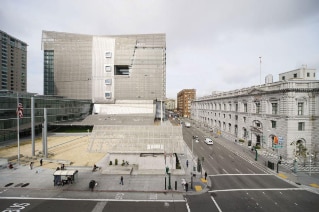In Portugal, this incredible capacity of producing world-class professionals in highly competitive areas finds correspondence only in architecture. Considering the last twenty years of the Pritzker Prize award, Portuguese architects have been awarded architecture's highest honour twice: in 1992 Álvaro Siza Vieira, and last year Eduardo Souto de Moura.
Recently however, these two architects have released distressful statements regarding Portugal's economic devastation. Álvaro Siza concluded that he might have to close his Oporto office due to the lack of work in the country, while Souto de Moura revealed that his office drastically shrunk in the last few months. At the last Ibero-American Biennial of Architecture and Urbanism, Siza also declared he feels as if living under a new dictatorship. In fact, the Portuguese democracy and state are under extreme pressure.
Since Portugal integrated the Euro Zone, it has continuously suffered financial difficulties. Last year, after a huge speculation process over the national debt, the government asked for a bailout, a foreign intervention by the troika constituted by the International Monetary Fund (IMF), the European Union and the European Central Bank. The requested loan of 78 thousand million euros, until know, has been used to pay interests and commissions (35 thousand million euros) and to capitalize commercial banks (12 thousand million euros), but each money transfer is preceded by the announcement of new cuts, austerity measures and the privatization of profitable shares of state companies.
But this is not new. What Portugal and Greece — and probably Spain and Italy — are passing through has been well described in Naomi Klein's research [1] on IMF interventions during the last century.
In 2000 Portugal had an unemployment rate of barely 4%, but according to the last Eurostat report it has reached 15,9% last August. The government is estimating that next year it may reach 16,4% — a figure currently considered too optimistic by most economists. Simultaneously, according to the Observatório das Desigualdades (Inequalities Observatory) in 2009 18% of the population was already living under the poverty line (with less then 385,00 €/month), and the 1%'s income percentile (regarding the total national income) was only comparable to USA and Brazil's, far ahead of China and India's richer classes. The gap between poor and richer has widened since then.
Siza and Souto de Moura's statements emerged in a moment when the majority of people are starting to understand that this road is taking the country into a dead end. This felling has been expressed by huge demonstrations and strikes that emerged throughout all of the country. The recent announcement of the national budget for 2013, negotiated by the government with the troika, increases taxing in lower wages and pensions and reinforces violent cuts on the welfare state (e.g., the health care ministry will have a dramatic 20% spending cut) while, simultaneously, keeping the Madeira island offshore and refusing to significantly increase taxes over financial transactions or higher wages and pensions. The mainstream reasoning from the political system in power is that the payment of the debt is the only priority, even if a lot of people will have to emigrate and the poorest and elder will have to die with no health care. The main political message is clear: only after paying — as if there were developed countries with no debt — can Portugal start thinking about itself.
Under this situation, professional areas that try to project the future — such as architecture, design or urbanism — are under attack. Government institutions, despite Portuguese architecture's international recognition, just ignore the field. Most of the population, far more concerned with keeping or looking for a job, pay their housing loan or to have money for two meals a day, consider it secondary. The dramatic corporation appeals made by the field's representatives, or the isolated statements of individual architects don't seem to help in finding a place for architecture in these tempestuous times, either.
But is architecture condemned? Are architects working in Portugal condemned to emigrate or to go jobless if they stay? Are architects needed during a financial crisis?
According to the Portuguese official data institute (INE), in the first semester of 2012 there have been 18 families per day that left their houses because they couldn't pay their loan to the bank. Until the end the year, this number is expected to rise to 8000. Some will move to a smaller house, some will share their current house, or perhaps rent it... In a significant part of these transition processes people may need the help of an architect. The problem is that they can't afford it.
On the other hand, as André Tavares has stated in Domus, important landmarks of Portuguese architecture from the last century are already under silent decay. From no maintenance, to ruin. But this is not only happening in relevant buildings. Over the last years, the territories that have been massively built upon, due to the demographic collapse (birth rate deflation plus emigration), are originating new constructed voids.
From these two examples, it becomes clear how wrong it is to declare that there is no work for architects in Portugal or any other country currently undergoing financial devastation. You may imagine how harmful it is for the most part of the population, to say that there are more architects than the country needs.
There is a lot to be done. There is a lot to be done in collaboration with the people that don't have the money to pay for architecture services. There is a lot to be done with those who live in worse conditions.
Through her research, Naomi Klein already defined how hard the financial situation can become. But there are several examples during the last decades, mainly in Latin American countries — as Brazil, Argentina or Chile —, that demonstrate how architects may play a decisive role in improving people's lives during and after a financial crisis.
In Portugal, architecture will have a future as long as it understands that in the next few years it has to work detached from markets, and mostly against their will. It has to understand that austerity policies are supported by the idea that people can't design and project a better life and future, which is violently against the fundamental principles of the métier. Architecture can't sit and wait to play its role in people's lives and I am convinced that the future will have to be about process, sharing, confronting and resisting.
Architects will have to stand where they are needed.
Tiago Mota Saraiva is a founding partner at Ateliermob, a Lisbon-based multidisciplinary platform which develops projects, ideas and research within architecture, design and urbanism. He currently writes a weekly column for the Portuguese newspaper i. Ateliermob, with the participatory project "Working with the 99 per cent", has recently been chosen as one of the winners of the Future Cities award at the 2012 Venice Architecture Biennale.
Notes:
1. Naomi Klein (2007). The Shock Doctrine, New York (USA). Metropolitan Books.






